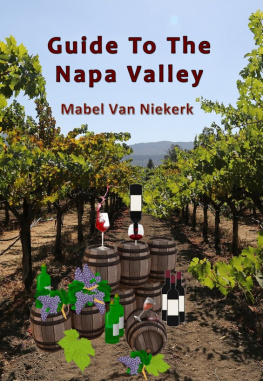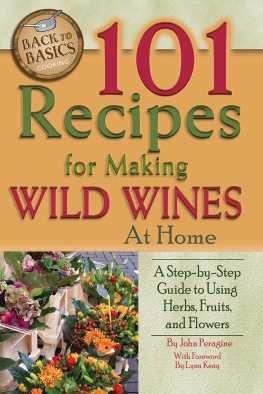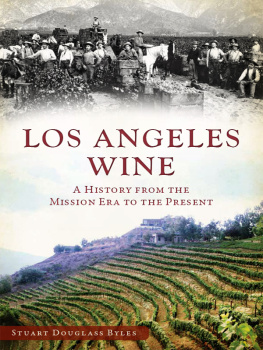Published by American Palate
A Division of The History Press
Charleston, SC
www.historypress.net
Copyright 2017 by George Walker and John Peragine
All rights reserved
Cover: Its harvest time at Guasti Vineyards. Mexican migrant workers fill the backs of trucks with thousands of tons of grapes to be transported back to the winery for crushing and pressing. Photo taken on October 26, 1937. Cal Poly Collections.
First published 2017
e-book edition 2017
ISBN 978.1.43966.254.0
Library of Congress Control Number: 2017940951
print edition ISBN 978.1.62585.911.2
Notice: The information in this book is true and complete to the best of our knowledge. It is offered without guarantee on the part of the authors or The History Press. The authors and The History Press disclaim all liability in connection with the use of this book.
All rights reserved. No part of this book may be reproduced or transmitted in any form whatsoever without prior written permission from the publisher except in the case of brief quotations embodied in critical articles and reviews.
ACKNOWLEDGEMENTS
We would like to thank all those who made this project possible. First of all, our familieswithout their support, we could not spend hours drinking, making, talking and writing about wine. We call it our vocation, while others might see it as our obsession.
There are some special people we wanted to mention up front, as they not only supported this project but also provided us material, photographs and, in some cases, some very tasty food and wine: Don Galleano and his son, Dominic; the staff at Galleano Winery; the staff at Mountain Vista Winery; Pierre and Michael Biane; Katie Richardson, Alexis Adkins and the terrific staff and students at Cal Poly Pomonas Special Collections Department; and Mark and Debbie Bianco.
George Walkers son, Clayton G. Walker, would like to add:
I am proud to play an active and integral role in the restoration of the Cucamonga Valley. Over the last ten years, my father and I have been diligently and committedly working to rescue as many remaining Cucamonga old vines as possible before they are destroyed by continuous urban development. Moreover, we have replanted various parts of Cucamonga with thousands of new vines, thanks to homeowners who have engaged us to help them attain their own vineyard dreams. Suffice it to say, MyHomeVineyard.com is passionate about the worlds most notable plantthe grapevine.
INTRODUCTION TO A
LOST WINEMAKING EMPIRE
The discovery of a wine is of greater moment than the discovery of a constellation. The universe is too full of stars.
Benjamin Franklin
Today, whenever someone mentions wine in California, the first places people think of are Sonoma and the Napa Valley, as these areas not only dominate the California wine industry but also are the top producers of wine in the world, due to their vast vineyards and gigantic production facilities. This may be where the industry is today, but it is not where it started. It really began much farther south, in an area of California that was once part of Mexico.
If you enjoy American wine, it is because of the dedicated farmers and winemakers who struggled to bring life to vineyards in a desert of sand ruled by jackrabbits. If it were not for the efforts of dedicated immigrant families, wine in California and within the United States would not exist as it does today. Prohibition had all but wiped out the wine industry, except in the sandy foothills of the San Gabriel Mountains.
Mel Blanc used to mention Cucamonga often in one of his bits on The Jack Benny Program. There would be a scene of a train station, and Mel Blanc would voice over, Train leaving on Track 5 for Anaheim, Azusa and Cu [pause] camonga! There were a number of viewers who thought the place and name were made up for the show. The exception was those who knew California wine.
Within the foreground of the San Gabriel Mountains is an area that was once the very heart of the wine industry. Cucamonga, now known as Rancho Cucamonga, was at the hub of this once thriving area. If you were to drive through this area now, you would see many industrial storage facilities covering the sandy soil that once held a vast acreage of sprawling vineyards.
The current city of Rancho Cucamonga is at the western edge of San Bernardino County. It is situated along Highways 66 (the famed Route 66) and 99 and extends north to Etiwanda on the east and Alta Loma on the west, stretching south to Ontario, Guasti and the Riverside County Line. The Cucamonga Valley, which was known decades ago as the Cucamonga-Guasti Wine District, included the communities of Alta Loma, Cucamonga, Etiwanda, Grapeland, Rochester, Ontario (Guasti), Fontana, Mira Loma (formerly known as Wineville), Rialto, Upland, North Ontario and Magnolia. It was an area steep in vineyards and was known for its wines, especially such Italian varietals such as Barbera, Grignolino, Zinfandel and Chianti.
Urban sprawl, vine disease and tax values for property caused these vineyards to be bulldozed and turned into large concrete edifices, which mark inevitable growth and progress as families and businesses moved eastward through the Inland Valley. Over time, the only evidence of the vast acres of grapevines are only a few hundred remaining acres of vines, historical markers and artwork integrated into street signs, as well as the architecture of some of buildings. If passersby look closely, they may also see a small vineyard planted in front of a home or in the courtyard of a business. These few relics pale in comparison to the scale of the twenty thousand contiguous acres that were once full of grapes of various varietals.
The once-thriving winegrowing industry in this area is important in a larger historical sense. Even during the Prohibition era, the area flourished economically, growing grapes and still legally making sacramental and prescription wine under federal permit, while other wineries and vineyards nationwide were abandoned or closed. Because Cucamonga continued to grow and even expand vineyards during this time, when the Volstead Act was finally repealed in 1933, the vineyards and local winemaking thrived and became the foundation of the new wine industry in California, not to mention the nation.
The area was a melting pot of different cultures and immigrants from all over the world, and this helped to make the grapes grown and the wines they produced legendary. Some of these vineyards still exist, although on a much smaller scale, and some are still farmed by the descendants of a few of those original families. With the continued urban sprawl and property values increasing, the next generations interest (or lack of interest) in taking over the family vineyard/winery business placed the future of these historic vineyards and wineries in a highly unsure light.












